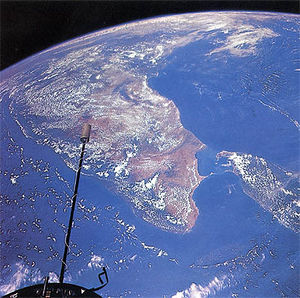Dhanuṣkoti
By Swami Harshananda
Dhanuṣkoti literally means ‘place sanctified by the extremity of the bow of Rāma’.
Dhanuṣkoti is also spelt as ‘Dhanuṣkoḍi’. It is an important place of pilgrimage of an ancient antiquity. It is surrounded by the island of Rāmeśvaram. It has derived it's name from an ancient legend. Rāma, at the request of the king Vibhīṣaṇa, destroyed the bridge built by the monkey-army with the koti[1] of his dhanuṣ.[2] He did this to prevent any future invasions of Laṅkā after Vibhīṣaṇa was crowned king. This small, but beautiful, temple-town is situated at a distance of 20 km (12.5 miles) from Rāmeśvaram. It was totally devastated by the fierce cyclone of A. D. 1964. Miraculously, only the temple of Kodaṇḍarāmasvāmi survived the cyclone and continues to stand today.
Kodaṇḍarāmasvāmi Temple[edit]
The place where the Kodaṇḍarāmasvāmi temple stands at present[3] is said to be the place where Vibhīṣaṇa[4] surrendered to Lord Rāma.
The temple can be approached by any four-wheeler for a distance of 10 km (6.2 miles). The rest of the journey has to be traveled on foot because the road is laden with sand.
The temple contains the images of Rāma, Sītā, Lakṣmaṇa, Hanumān and Vibhīṣaṇa.
Geographical Significance of Dhanuṣkoti[edit]
Dhanuṣkoti has 3 major points of significance:
- It is the location where the Bay of Bengal meets the Indian Ocean--hence, this This Dhanuṣkoti is also called Ratnākara. Pilgrims take a bath here and perform śrāddha.
- There is a (now) underwater bridge made of a number of boulders in the shallow waters up to Śri Lanka. It is referred as ‘Adam’s Bridge’. This bridge is believed to be the remnant of the famous bridge built by Rāma's monkey army during his invasion to Laṅkā. A recent satellite picture seems to indicate the remnants of a very old bridge here.
- At the edge of the island, there is a range of sand-dunes popularly called as ‘floating stones’.
References[edit]
- The Concise Encyclopedia of Hinduism, Swami Harshananda, Ram Krishna Math, Bangalore


